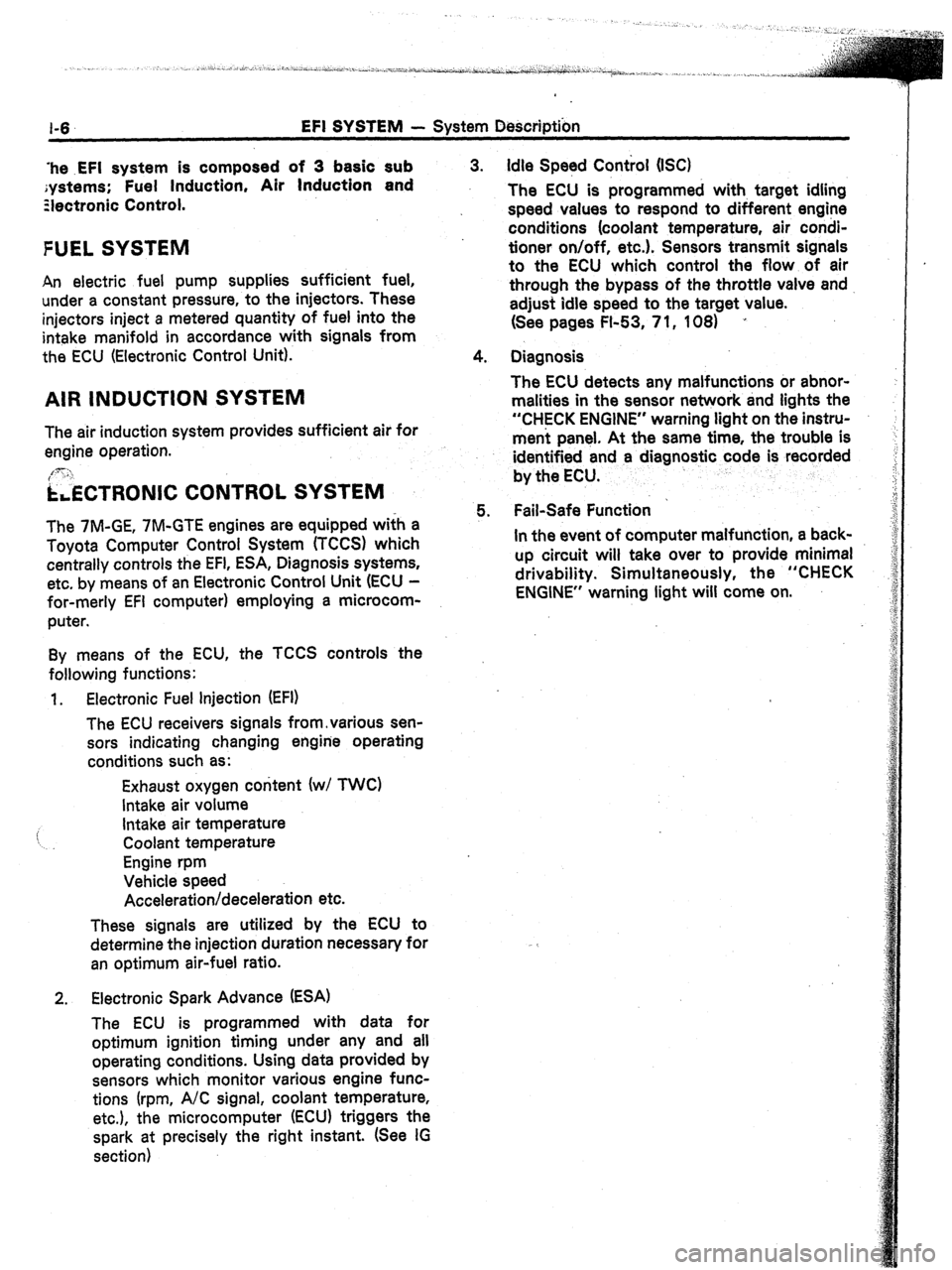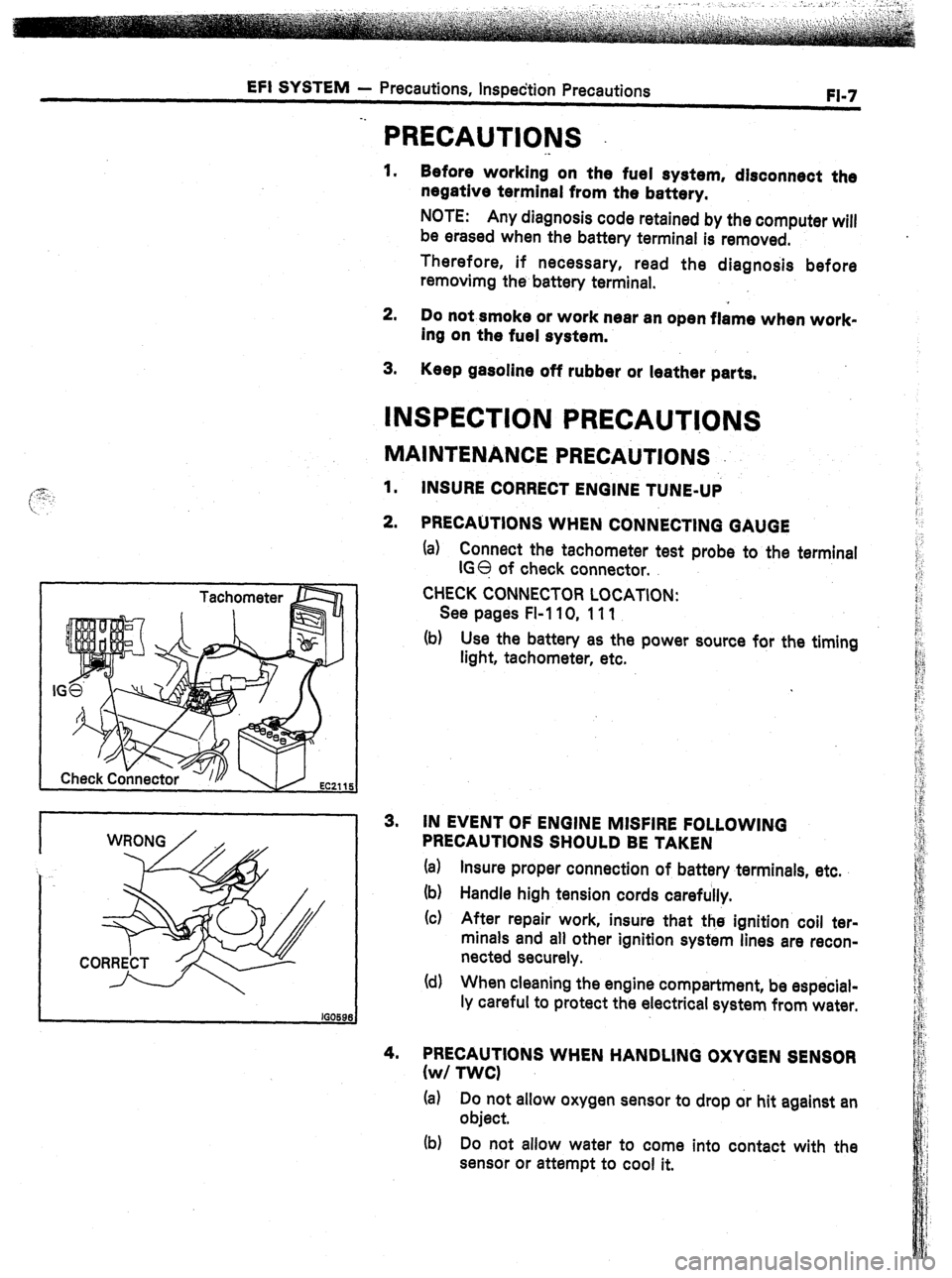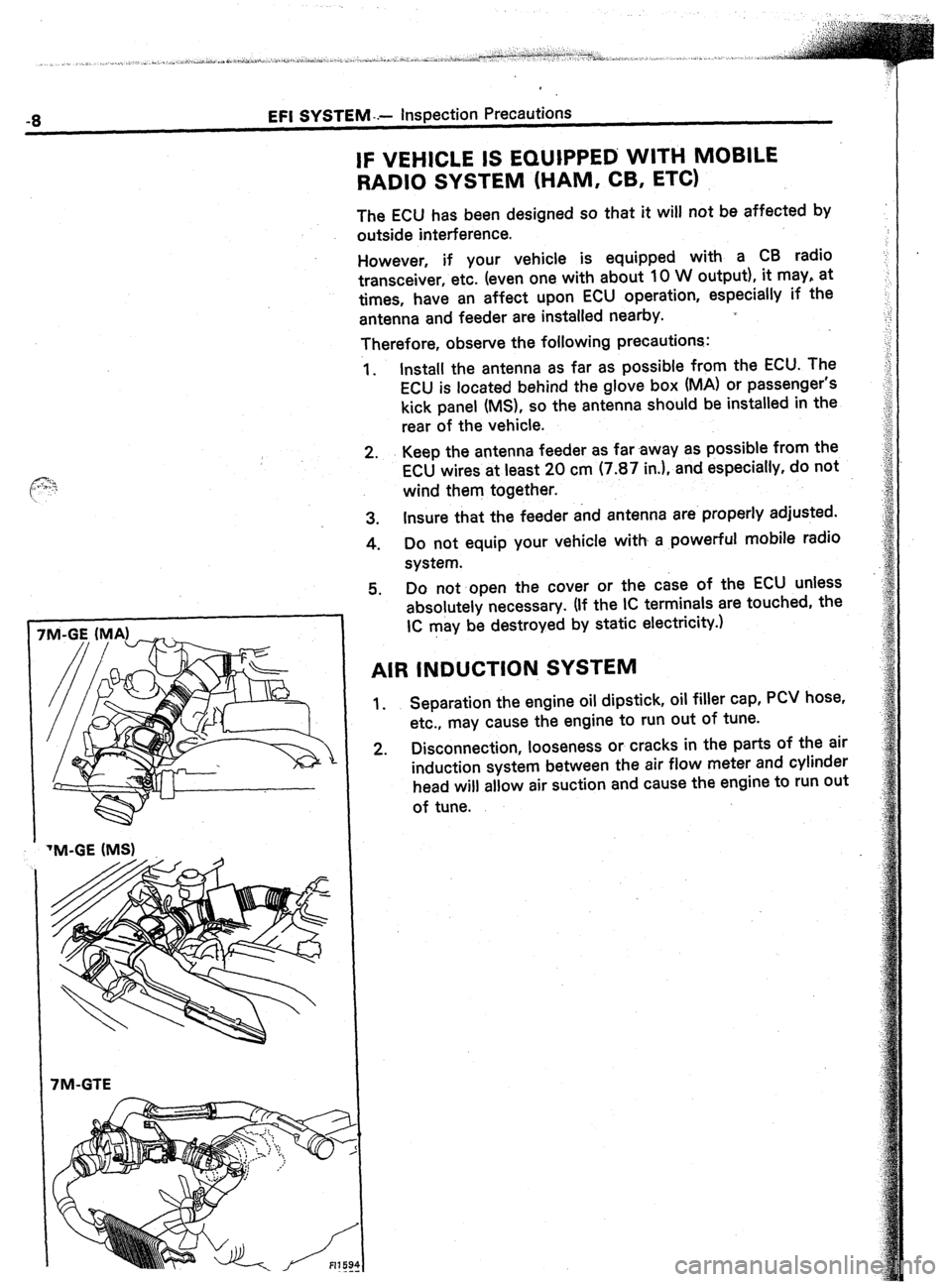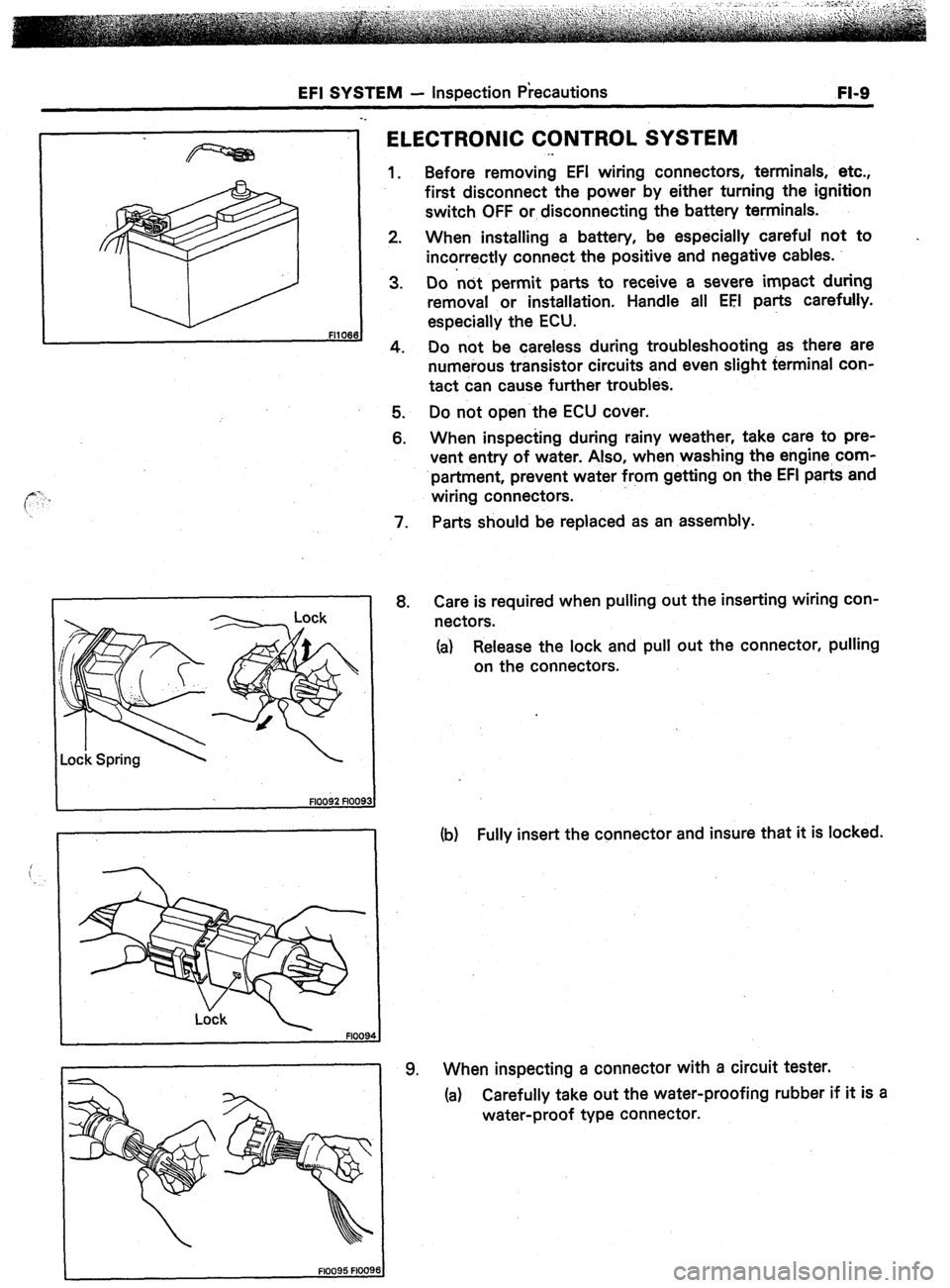Page 40 of 346

1-6 EFI SYSTEM - System Description
‘he .EFI system is composed of 3 basic sub
;ystems; Fuel Induction, Air Induction and
Ziectronic Control.
FUEL SYSTEM
An electric fuel pump supplies sufficient fuel,
under a constant pressure, to the injectors. These
injectors inject a metered quantity of fuel into the
intake manifold in accordance with signals from
the ECU (Electronic Control Unit).
AIR INDUCTION SYSTEM
The air induction system provides sufficient air for
engine operation.
[3: ‘I
i&TRONIC CONTROL SYSTEM
The 7M-GE, 7M-GTE engines are equipped wifh a
Toyota Computer Control System (TCCS) which
centrally controls the EFI, ESA, Diagnosis systems,
etc. by means of an Electronic Control Unit (ECU -
for-merly EFI computer) employing a microcom-
puter.
By means of the ECU, the TCCS controls the
following functions:
1. Electronic Fuel injection (EFI)
The ECU receivers signals from,various sen-
sors indicating changing engine operating
conditions such as:
Exhaust oxygen content (w/ TWC)
Intake air volume
i Intake air temperature
Coolant temperature
Engine rpm
Vehicle speed
Acceleration/deceleration etc.
These signals are utilized by the ECU to
determine the injection duration necessary for
an optimum air-fuel ratio.
2. Electronic Spark Advance (ESA)
The ECU is programmed with data for
optimum ignition timing under any and all
operating conditions. Using data provided by
sensors which monitor various engine func-
tions (rpm, A/C signal, coolant temperature,
etc.), the microcomputer (ECU) triggers the
spark at precisely the right instant. (See IG
section) 3. Idle Speed Control (IX)
The ECU is programmed with, target idling
speed values to respond to different engine
conditions (coolant temperature, air condi-
tioner on/off, etc.). Sensors transmit signals
to the ECU which control the flow of air
through the bypass of the throttle valve and
adjust idle speed to the target value.
(See pages FI-53, 7 1, 108) ’
4. Diagnosis
The ECU detects any malfunctions or abnor-
malities in the sensor network and tights the
“CHECK ENGINE” warning light on the instru-
ment panel. At the same time, the trouble is
identified and a diagnostic code is recorded
by the ECU.
5. Fail-Safe Function ’
In the event of computer malfunction, a back-
up circuit will take over to provide minimal
drivability. Simultaneously, the “CHECK
ENGINE” warning light will come on.
Page 41 of 346

EFI SYSTEM
- Precautions, Inspection Precautions
FI-7
PRECAUTIONS
._
1. Before working on the fuel system, disconnect the
negative terminal from the battery.
NOTE: Any diagnosis code retained by the computer will
be erased when the battery terminal is removed.
Therefore, if necessary, read the diagnosis before
removimg the battery terminal.
2. Do not smoke or work near an open flame when work-
ing on the fuel system.
3. Keep gasoline off rubber or leather parts.
INSPECTION PRECAUTl.ONS
MAINTENANCE PRECAUTIONS
1. INSURE CORRECT ENGINE TUNE-UP
2. PRECAUTIONS WHEN CONNECTING GAUGE
(a) Connect the tachometer test probe to the terminal
IGO of check connector.
CHECK CONNECTOR LOCATION:
See pages FI-110, 111
(b) Use the battery as the power source for the timing
light, tachometer, etc.
3. IN EVENT OF ENGINE MISFIRE FOLLOWING
PRECAUTIONS SHOULD BE TAKEN
(a) Insure proper connection of battery terminals, etc.
(b) Handle high tension cords carefully.
(c) After repair work, insure that the ignition coil ter-
minals and all other ignition system lines are recon-
nected securely.
(d) When cleaning the engine compartment, be especial-
ly careful to protect the electrical system from water.
4. PRECAUTIONS WHEN HANDLING OXYGEN SENSOR
(w/ TWCI
(a) Do not allow oxygen sensor to drop or hit against an
object.
(b) Do not allow water to come into contact with the
sensor or attempt to cool it.
Page 42 of 346

-8 EFI SYSTEM -.- Inspection Precautions
IF VEHICLE IS EQUIPPED WITH MOBILE
RADIO SYSTEM (HAM, CB, ETC)
The ECU has been designed so that it will not be affected by
outside interference.
However, if your vehicle is equipped with a CB radio
transceiver, etc. (even one with about 10 W output), it may, at
times, have an affect upon ECU operation, especially if the
antenna and feeder are installed nearby.
Therefore, observe the following precautions:
1. Install the antenna as far as possible from the ECU. The
ECU is located behind the glove box (MA) or passenger’s
kick panel (MS), so the antenna should be installed in the
rear of the vehicle.
2. Keep the antenna feeder as far .away as possible from the
ECU wires at least 20 cm (7.87 in.), and especially, do not
wind them together.
3. Insure that the feeder and antenna are properly adjusted.
4. Do not equip your vehicle with a powerful mobile radio
system.
Do not open the cover or the case of the ECU unless
absolutely necessary. (If the IC terminals are touched, the
. . .
IC may be destroyed by static electricity.1
AIR INDUCTION SYSTEM
1.
2. Separation the engine oil dipstick, oil filler cap, PCV hose,
etc., may cause the engine to run out of tune.
Disconnection, looseness or cracks in the parts of the air
induction system between the air flow meter and cylinder
head will allow air suction and cause the engine to run out
of tune.
TM-GE (MS)
7M-GTE
Page 43 of 346

EFI SYSTEM - inspection Precautions
FI-9
FM066
FlOO95 FlOO91
ELECTRONIC CONTROL SYSTEM
1.
2.
3. Before removing EFI wiring connectors, terminals, etc.,
first disconnect-the power-by either turning the ignition
switch OFF or disconnecting the battery terminals.
When installing a battery, be especially careful not to
incorrectly connect the positive and negative cables.
Do not permit parts to receive a severe impact during
removal or installation. Handle all EEI parts carefully.
especially the ECU.
4. Do not be careless during troubleshooting as there are
numerous transistor circuits and even slight terminal con-
tact can cause further troubles.
5.
6. Do not open the ECU cover.
When inspecting during rainy weather, take care to pre-
vent entry of water. Also, when washing the engine com-
.partment, prevent water from getting on the EFI parts and
wiring connectors.
7. Parts should be replaced as an assembly.
8. Care is required when pulling out the inserting wiring con-
nectors.
(a) Release the lock and pull out the connector, pulling
on the connectors. .
(b) Fully insert the connector and insure that it is locked.
9. When inspecting a connector with a circuit tester.
(a) Carefully take out the water-proofing rubber if it is a
water-proof type connector.